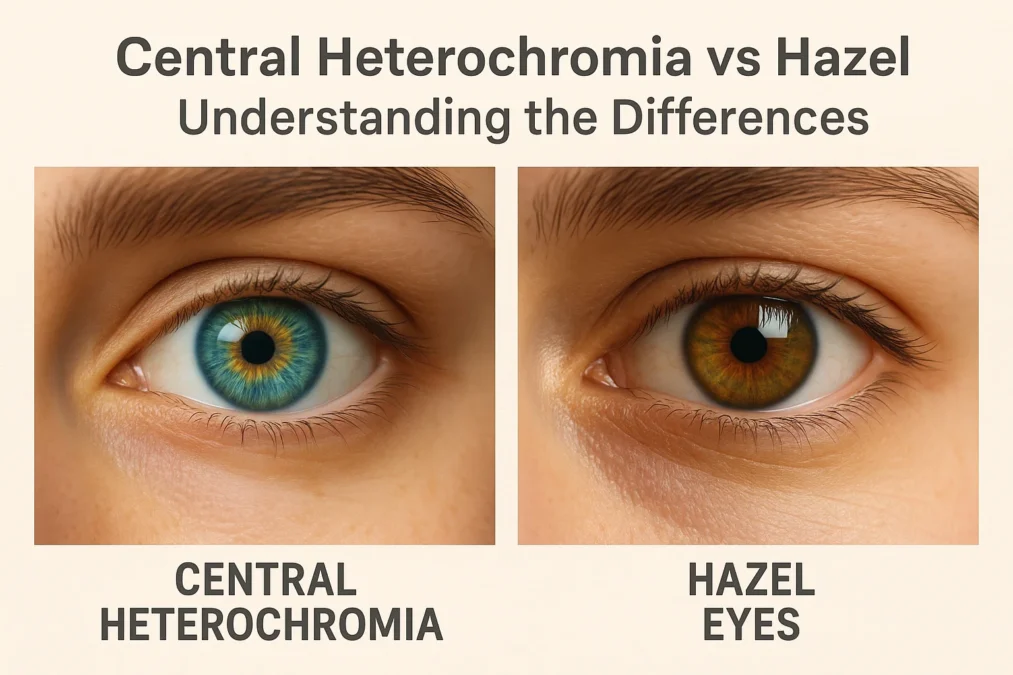When it comes to eye colors, few topics spark as much curiosity as central heterochromia vs hazel eyes. Both conditions create unique and captivating eye appearances, but they are often confused with one another. In this article, we’ll dive deep into the differences between these two eye phenomena, explore their causes, and provide visual examples to help you distinguish between them. Whether you’re curious about green central heterochromia vs hazel or want to see central heterochromia vs hazel pictures, this guide has you covered.
What is Central Heterochromia?
Central heterochromia is a rare eye condition where the iris displays two distinct colors. Typically, the inner ring of the iris is a different color than the outer ring. For example, someone with central heterochromia might have a golden or brown inner ring surrounded by a blue or green outer ring. This condition is caused by variations in melanin distribution in the iris.
Causes of Central Heterochromia
Central heterochromia is usually a genetic trait, meaning it’s inherited from one or both parents. It can also occur due to:
- Genetic mutations during embryonic development.
- Injury or trauma to the eye, though this is less common.
- Medical conditions like Horner’s syndrome or Waardenburg syndrome.
Examples of Central Heterochromia
- A person with a green outer iris and a golden-brown inner ring.
- Someone with a blue outer iris and a gray or hazel inner ring.
What are Hazel Eyes?
Hazel eyes are a blend of multiple colors, typically green, brown, and gold. Unlike central heterochromia, hazel eyes don’t have a distinct separation of colors. Instead, the colors blend seamlessly, creating a gradient effect. Hazel eyes are more common than central heterochromia and are often associated with warmth and depth.
Causes of Hazel Eyes
Hazel eyes are primarily determined by genetics. The interplay of melanin and light scattering in the iris creates the unique hazel appearance. Factors influencing hazel eyes include:
- Genetic inheritance from parents.
- Rayleigh scattering, which causes the green and gold hues to appear.
Examples of Hazel Eyes
- A person with a mix of green and brown tones that shift depending on lighting.
- Someone with golden flecks scattered throughout a predominantly green iris.
Invisalign vs Braces: Which Orthodontic Treatment is Right for You?
Central Heterochromia vs Hazel Eyes: Key Differences
While both conditions involve multiple colors in the iris, there are distinct differences between central heterochromia vs hazel eyes:
| Feature | Central Heterochromia | Hazel Eyes |
|---|---|---|
| Color Distribution | Two distinct colors (inner vs. outer ring) | Blended colors with no clear rings |
| Appearance | Ring-like pattern | Gradient or speckled effect |
| Common Colors | Blue, green, brown, gold, gray | Green, brown, gold |
| Rarity | Rare | More common |
| Cause | Genetics, injury, or medical conditions | Genetics and light scattering |
Green Central Heterochromia vs Hazel
One of the most common comparisons is green central heterochromia vs hazel. Here’s how to tell them apart:
- Green Central Heterochromia: The inner ring might be gold or brown, while the outer ring is green. The colors are distinctly separated.
- Hazel Eyes: The green and brown tones blend together, often with golden flecks. There’s no clear separation between colors.
Central Heterochromia vs Hazel Pictures
Visual examples can help clarify the differences. Below are descriptions of central heterochromia vs hazel pictures:
- Central Heterochromia: A photo showing a clear golden ring around the pupil, surrounded by a blue or green outer iris.
- Hazel Eyes: A photo displaying a mix of green and brown tones that blend seamlessly, with no distinct rings.
Frequently Asked Questions (FAQs)
1. Can central heterochromia develop later in life?
Yes, though rare, central heterochromia can develop due to injury, illness, or certain medications.
2. Are hazel eyes a form of heterochromia?
No, hazel eyes are not a form of heterochromia. They are a result of blended colors, not distinct rings.
3. Which is rarer: central heterochromia or hazel eyes?
Central heterochromia is rarer than hazel eyes.
4. Can lighting affect the appearance of hazel eyes?
Yes, hazel eyes often appear to change color depending on lighting and surroundings.
5. Is central heterochromia harmful?
No, central heterochromia is typically harmless and doesn’t affect vision.
Conclusion
Understanding the differences between central heterochromia vs hazel eyes can help you appreciate the beauty and complexity of human eye colors. While central heterochromia features distinct rings of color, hazel eyes showcase a seamless blend of tones. Whether you’re admiring green central heterochromia vs hazel or exploring central heterochromia vs hazel pictures, both conditions highlight the fascinating diversity of our eyes.
This article provides a comprehensive overview of central heterochromia vs hazel eyes, making it easy to understand and visually engaging. Whether you’re a curious reader or someone researching eye colors, this guide offers valuable insights and answers to common questions.



